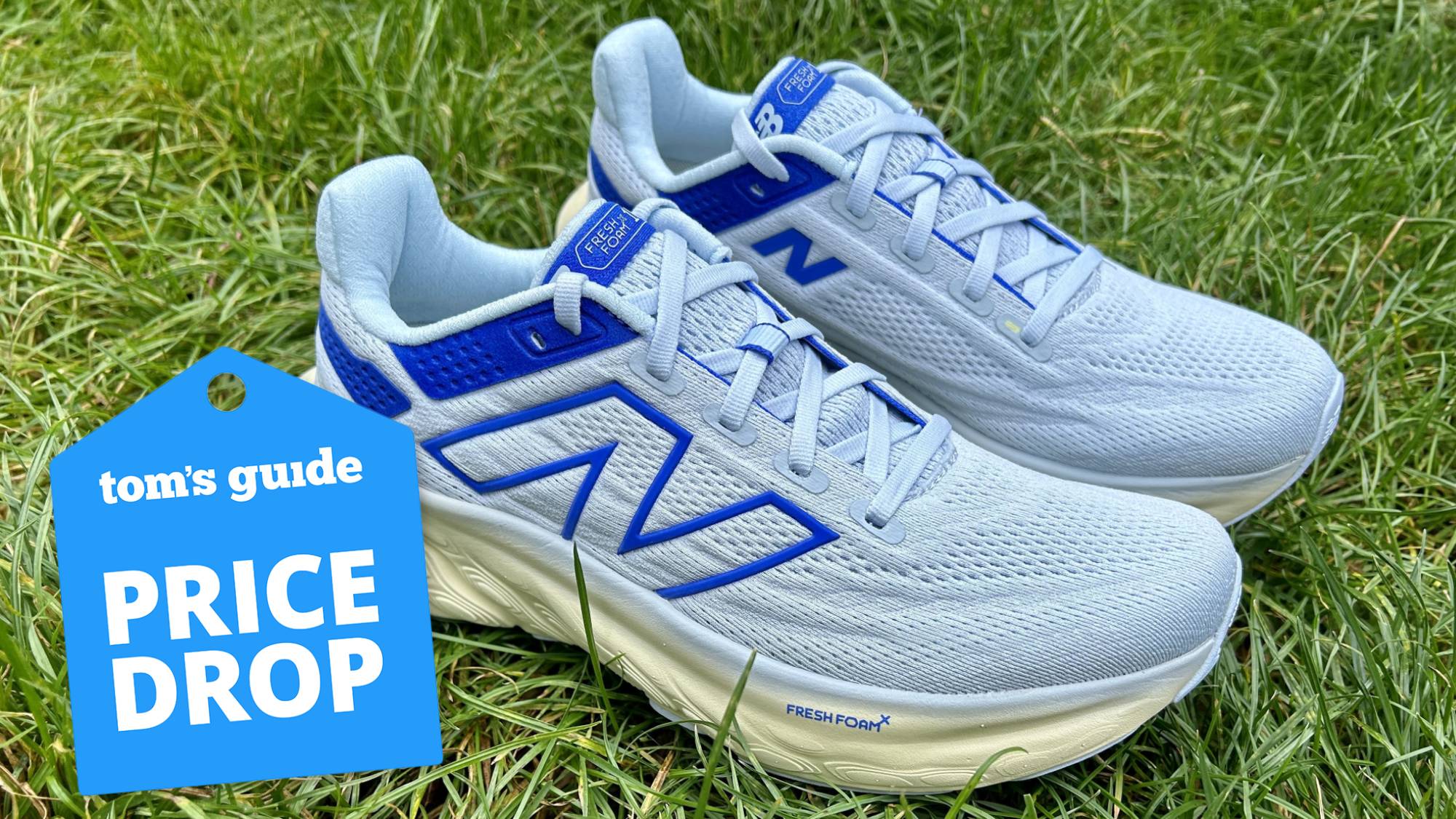Fujifilm X-T1 Mirrorless Camera Review: Fast Shooter
Fuji’s latest X-model, the $1300 X-T1 is fast, sealed against the elements and primed for action wherever you go.
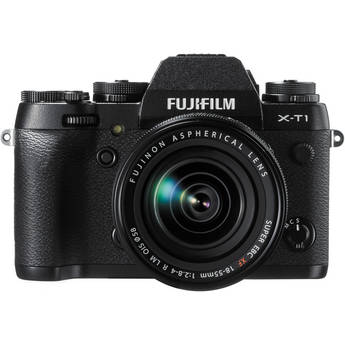
Not everyone is keen on retro digital cameras, but those who are — be they enthusiasts or pros — can tap some analogue nostalgia with the Fujifilm X-T1. The latest addition to Fujifilm’s popular X-series mirrorless cameras, the midrange, 16-megapixel X-T1, is available body only for $1300 (list price) or with an 18-55mm kit lens for $1700. Its old-school design is attractive and, like the $2,750 Nikon Df, is outfitted with mechanical dials for adjusting exposure and other parameters.
Those who prefer the beach or the boat to dry land, will appreciate the camera’s weatherproof sealing. And, the X-T1's great autofocus and continuous shooting are fast enough to keep up with skittish wildlife, high-energy dancers, and sports such as mountain biking or skiing. (For weatherproof compact cameras, see Best Waterproof and Rugged Cameras.)
Who it’s for
Old-school photo enthusiasts who don't shoot much video; people who shoot out in the wild or photograph lots of action.
Design: ready for the elements
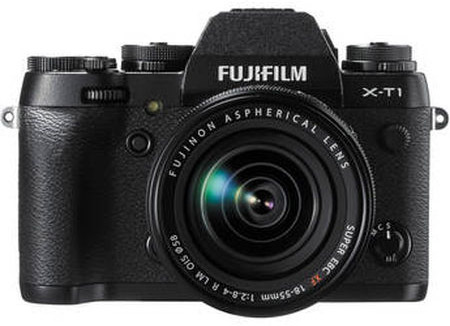
Outdoor photographers who brave all kinds of weather to get the shot will appreciate the X-T1’s rugged magnesium body. The design prevents moisture, dust, sand and other elements from entering the camera. Like the similarly sealed Olympus OM-D E-M1, the X-T1 requires a weather-sealed lens to make the entire setup immune to the elements. (There’s only one right now, with more to come—see the lens section of this review for more info.)
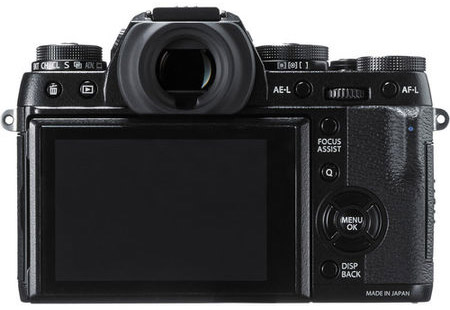
Another notable feature is the 1024 x 768 OLED electronic viewfinder (EVF). It’s large, bright and clear; and offers several viewing options. Dual mode, for example, displays a large version of the image on the left and a smaller, magnified view of the focus area on the right. The latter makes it easy to bring the subject into focus.
Image quality
The X-T1 produces excellent images overall. I used the XF 35mm, f/1.4 lens for most of the test shots with the camera set to sRGB color space and Standard film simulation (picture style) mode. Fujifilm cameras have modes that simulate some of the company's classic film stocks. Standard is the most color-accurate.
Each image was captured in simultaneous fine JPEG as well as RAW file formats, except when the ISO was set above 6400, when the RAW option was unavailable. This is an unusual restriction we haven't encountered with other cameras and a notable limitation for editing high-ISO images, as ISO goes all the way to 51,200.
Get instant access to breaking news, the hottest reviews, great deals and helpful tips.
When we asked Fujifilm why RAW capability is lacking for higher ISOs, the company said only that, "This is expanded ISO range - RAW does not work in this range." Expanded ranges are beyond what the camera maker recommends for best quality, but other cameras, including the X-T1's close rival, the weather-sealed Olympus OMD-EM1, can shoot RAW files at expanded ISOs (the EM1's expanded range is from over 5000 up to 25,600.)
Bright conditions
With few exceptions, the Fujifilm X-T1 captured images with rich and accurate colors--without being oversaturated. Likewise, Exposures were almost always dead-on accurate, with a good range of shadows and highlights, as seen in this photo of Midtown Manhattan.
In this shot on a cloudless day, taken with the 35mm lens, the X-T1’s exposure, dynamic range and detail capture are excellent. This was shot at f/8.0, 1/340 second at ISO 200.
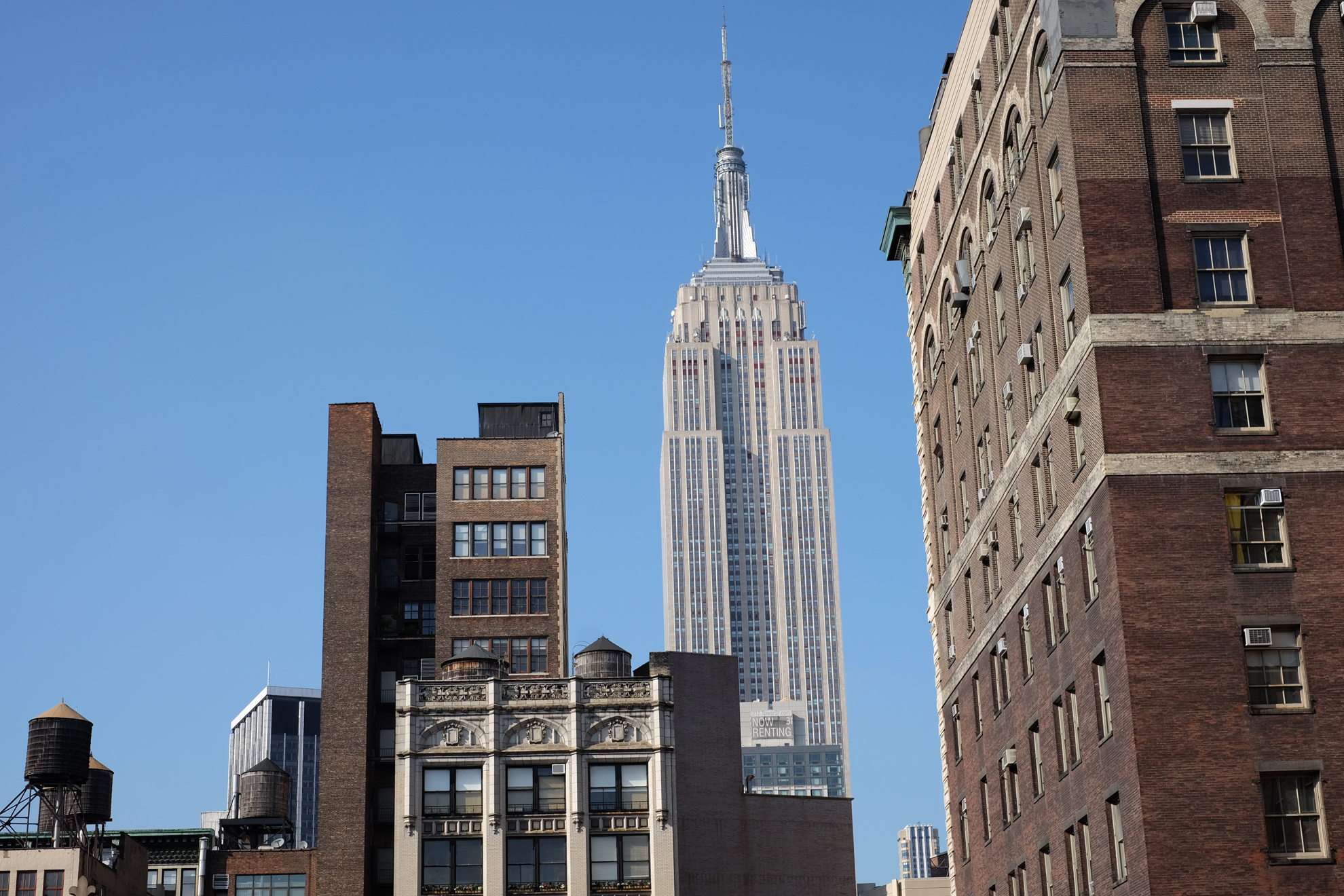
MORE: How to Take Great Photos with a DSLR or Mirrorless Camera
The camera’s metering is quite capable. We pushed it to the limit photographing dancers in New York City’s Bryant Park in the afternoon. In multi-metering mode (which evaluates the whole frame, versus center or spot), we saw some blown-out highlights in the brightly lit buildings and underexposed shadows in the trees. But that's to be expected. More important, the camera exposed the dancers--the subject of our shot--very well. Some of the dancers’ skin appears a little pink, but that's likely natural, as they were working up a sweat.
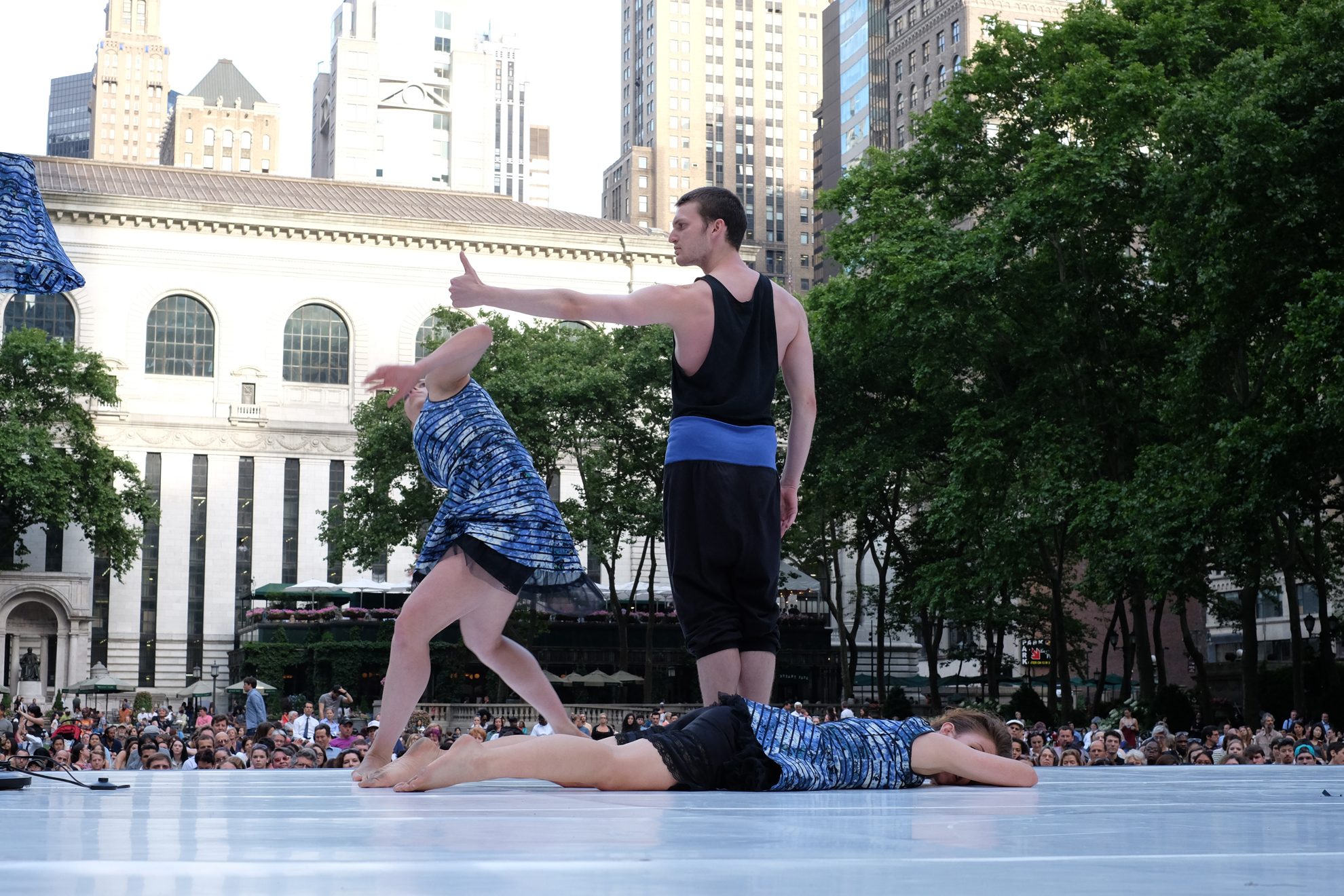
Metering was very good in less extreme, but still challenging settings, such as this second view of the Empire State Building through the trees of Madison Square Park. In pattern metering, the camera maintains detail in the bright sky (although the color is off a bit) and keeps most of the foliage bright enough to retain some detail.
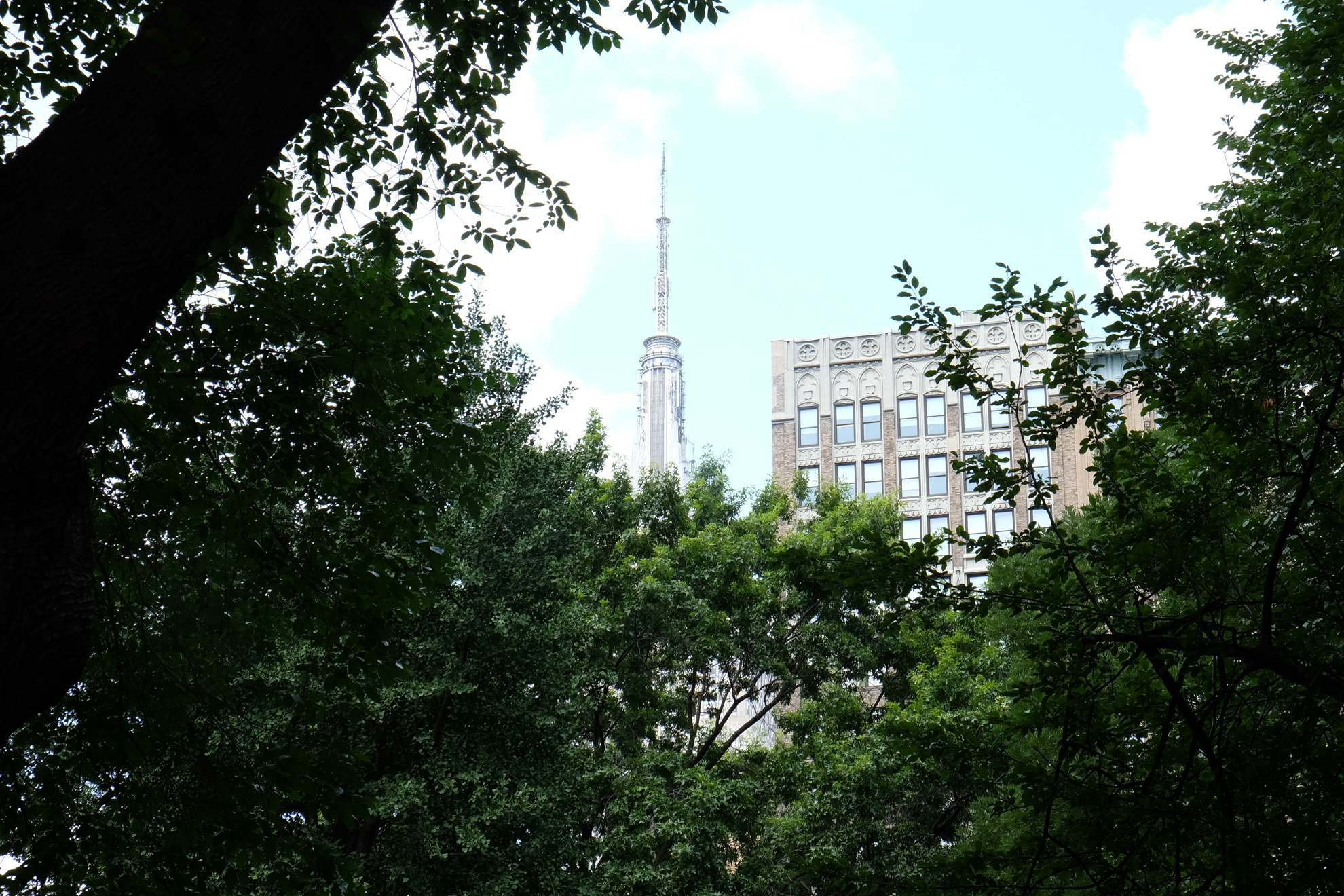
Overall, images were sharp and delivered good detail. Even this close-up, shot with the 35mm lens, was surprisingly crisp and shows the delicate parts of the flower.
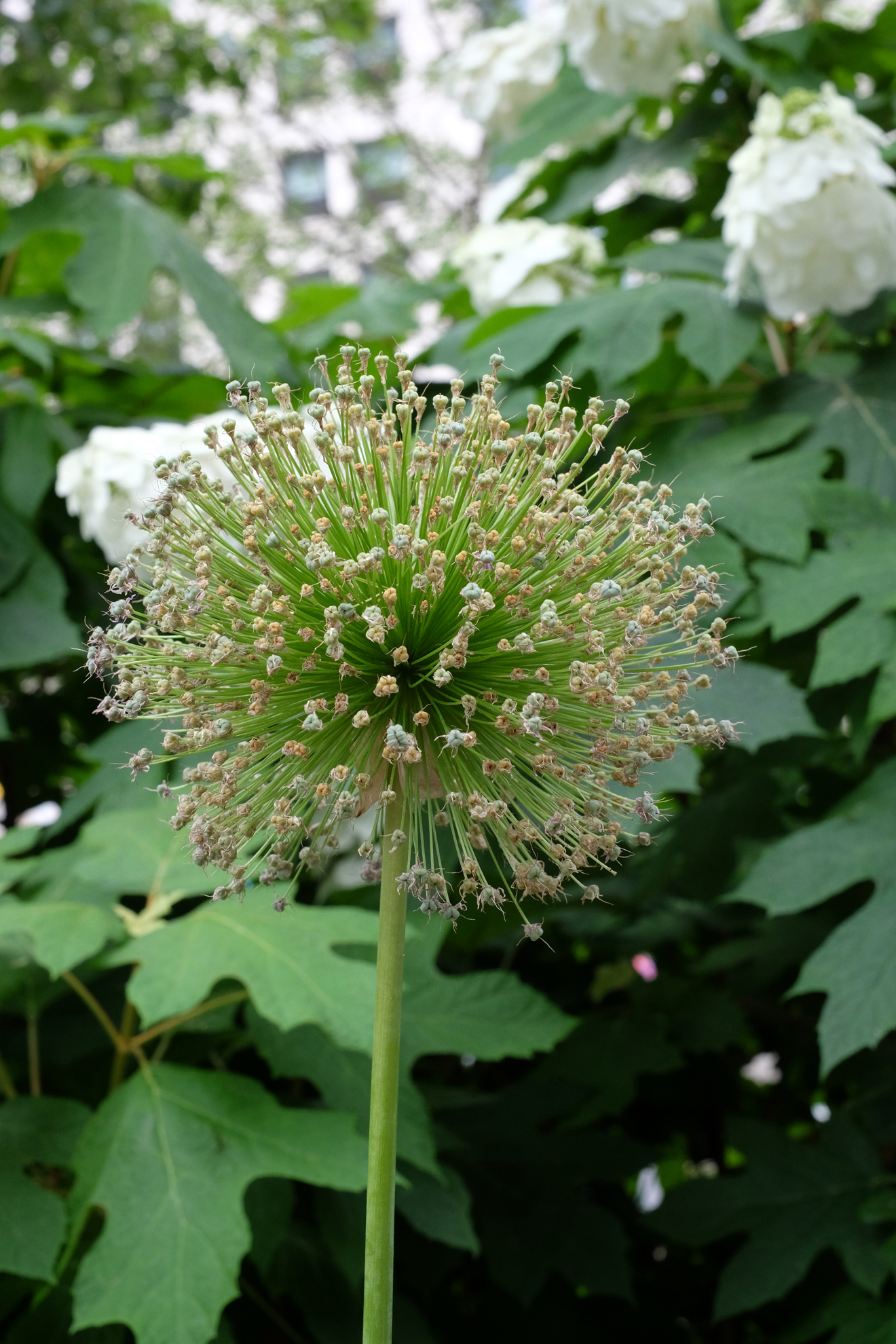
Low-light conditions
Shooting in low light is all about compromise between shutter speed, aperture/depth-of-field and light sensitivity (ISO). Fortunately, Fujifilm's 35mm lens has a large f/1.4 maximum aperture. Opening wide to f/1.4 naturally cuts down on depth-of-field (sharpness from near to far), but makes it possible to balance a hand-holdable shutter speed of with a lower ISO, resulting in less image noise (graininess).
The lobby of the Museum of Modern of Art receives a mix of artificial and some natural light, and the X-1’s automatic white balance handled the mixed lighting very well. Positioned on the mezzanine level and steadying the camera on the edge of a railing to compensate for the 1/60 of a second shutter speed, I shot down to capture these relaxing visitors. Most of the subjects are in focus thanks to the lens’ wide angle, but shooting at f/1.4 meant I lost a little focus on the person in the lower left. Shot at ISO 800, the image is impressively free of image noise (graininess).

Also shot with the 35mm lens at f/1.4 (this time at ISO 1600) this scene looking up Broadway achieves good overall exposure (in pattern metering), although it does over illuminate the sky. The Auto White Balance is especially good, considering the heavy amber cast of the streetlight.
MORE: Street Photography Lessons: How to Get the Best Shot
However, the chromatic aberration — purple fringes on areas of high contrast — is pronounced and appears on nearly every light. You can even see it at low resolution, in areas such as the lights under the scaffolding in the right-rear of the photo. Chromatic aberration is usually the fault of the lens; some cameras have built-in algorithms to reduce or remove it in photo files.
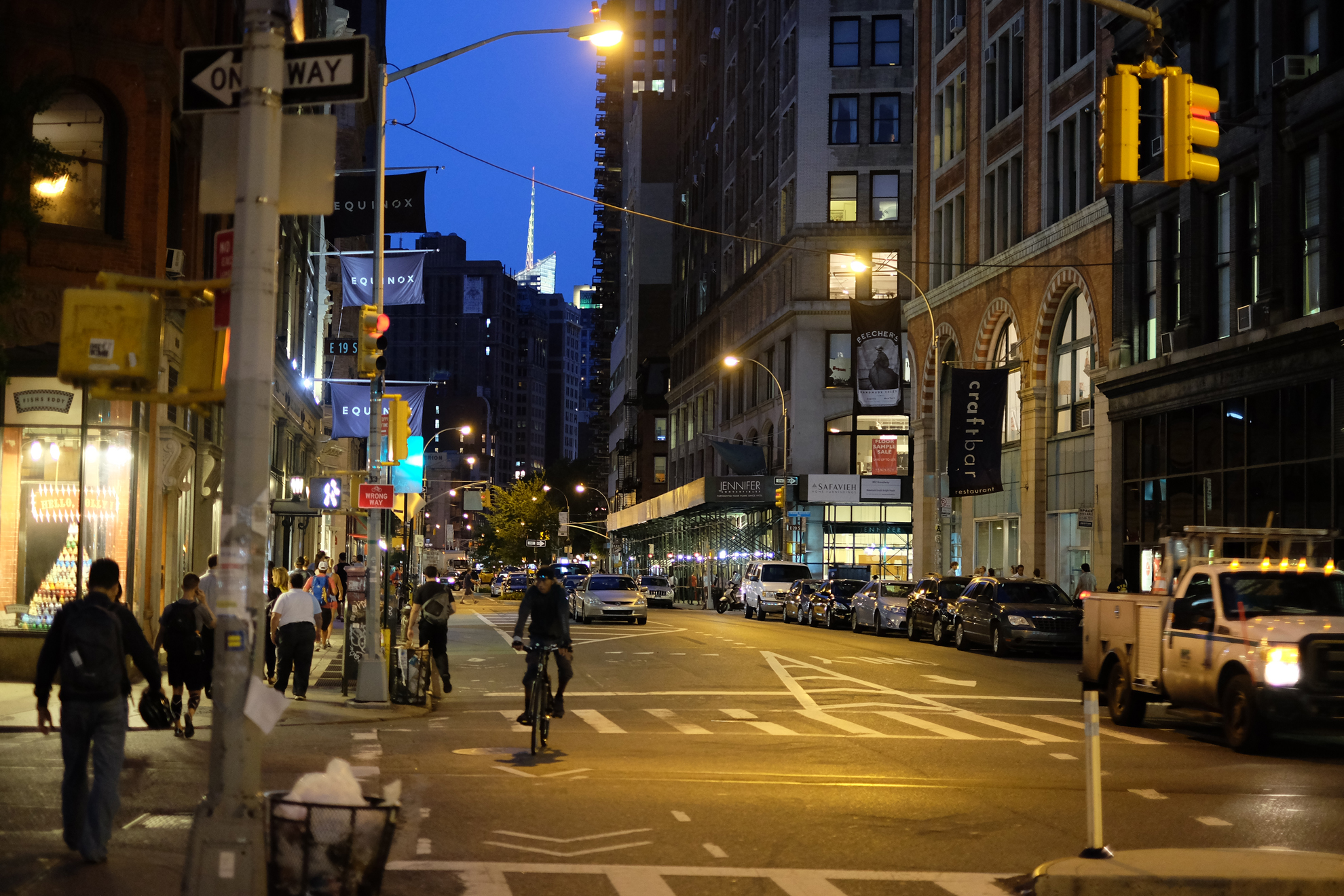
Pushing the light sensitivity higher to ISO 6400, we shot this photo of the WWII aircraft carrier USS Intrepid docked on the Hudson that shows very little noise. The hull of the ship is lit by spotlights, but the sky was quite dark, and the X-T1 pulled out a lot of color and detail without getting too grainy.

In its "Extended ISO" mode, the X-T1 is capable of shooting at an unusually high ISO 51,200, but that requires going into the menu to customize the ISO dial. Not surprising: The image quality at 51,200 — with or without in-camera noise reduction — is unacceptable for even the smallest print and not even worth showing.
Video quality
Video is the X-T1’s major shortfall for anything more than casual clips to show family and friends. Exposure controls are limited to exposure compensation, which can be adjusted up to +/- 2 EV during recording. (Each EV represents a doubling or halving of light intake.) You can adjust microphone levels, and Intelligent Face Detection is available in both continuous and single autofocus modes.
The X-T1 can record video at 1920 x 1080 at 60p or 30p, or at 1280 x 720 at 60p or 30p in the .MOV format (using H.264 compression). Because of the .MOV format, videos are easy to edit and can be played back in QuickTime.
Test videos were captured at the highest resolution (1920 x 1080, 60p) with single or continuous AF and with the exposure compensation set at 0.
Audio quality wasn’t bad; and if you want better sound, you can pick up an optional microphone that plugs into the camera's 3.5mm audio-in jack. But image quality was marred by moiré — lines that seem to shimmer and move on buildings and other structures with fine details in both bright light and low light, as shown in the videos below.
MORE: How to Shoot Great Video
Autofocus was, overall, fairly responsive with both the 35mm lens and the 18-55mm kit lens. But auto exposure when moving from a light to a dark scene (or vice versa) in daylight was less responsive, requiring longer to adjust than most cameras in this class would take. Scenes shot under bright daylight tended to be overexposed.
For low-light, we took a brief video of an outdoor performance of Othello, using the 35mm lens. It's not beautiful, but considering the very limited and harsh artificial light, the quality is quite good. Audio is also pretty clear, given the slight breeze and the mix of voices and music coming from on and off stage. (Apologies for the camera shake.
Fujifilm recently issued a firmware update for the X-T1 that delays the start of video recording after the Record button is pushed. Since the button is tiny and positioned at the right corner of the top panel, it’s hard to press without shaking the camera. The delay afforded by the firmware gives you time to steady the camera before recording starts. But pressing the button to stop recording is still awkward because of the position and small size of the button; this often resulted in a tilt of the camera while pushing the button (as you can see in my at the end of my video of the dancer).
Autofocus and speed
Fujifilm claims the “world’s fastest AF speed of 0.08 seconds.”While I can’t confirm that speX-T1 is highly responsive in both bright and low light. The X-T1 uses both DSLR-style phase-detection as well as contrast-detection autofocus technologies in its Hybrid AF system, along with a new algorithm optimized for low light/low contrast subjects.
Speed is nothing without accuracy, and the camera’s AF is generally on target. I encountered a problem only while photographing dancers at Bryant Park: Sometimes a dancer ended out-of-focus when the camera suddenly shifted focus to people in the background.
By turning on the camera’s continuous AF, the X-T1 did much better at tracking moving subjects. I recommend using continuous AF when photographing people in motion. This mode was particularly useful when taking advantage of the X-T1’s other strength: up to 8fps continuous shooting speed.
MORE: Camera Wars: Why Autofocus is the New Megapixel
You can see the benefits of continuous autofocus in these photos of a woman walking towards us in Madison Square Park. We used a relatively shallow depth of field (with an f-5 aperture) so that there would be no fudge room if the camera lost focus on the woman. Aside from some inevitable motion blur at the 1/125 second shutter speed, she remains crisp in every shot.
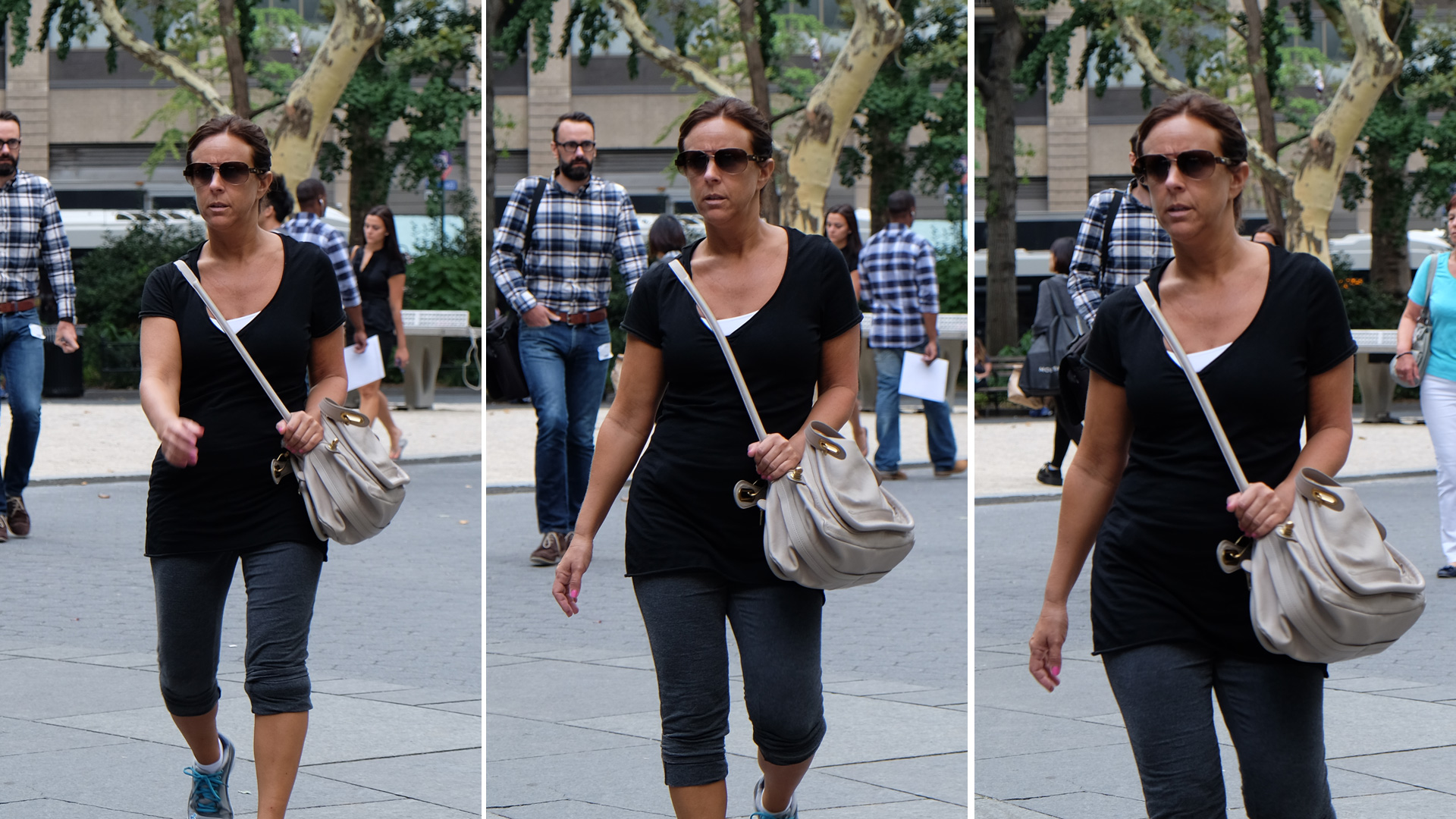
The X-T1 is the first camera compatible with the latest — and fastest — UHS II SD memory cards. I tested the camera with both the 16 GB Toshiba Exceria Pro and the 64GB SanDisk UHS II cards. I couldn’t tell the difference between the two (if any, it was probably minor) but read and write speeds were — as promised — quite fast. If you can swing it, pick up a UHS II card for the X-T1.
Startup time was fast, too, thanks in part to the camera’s dual CPUs and the combination of the camera’s X-Trans CMOS II image sensor and EXR Processor II.
Controls: old-school analog
As with the Nikon Df, retro styling on the Fujifilm X-T1also means a shift from the norm in terms of controls. Some photographers will be at ease with the analogue dials and levers — shutter speed, exposure compensation, light metering, ISO and drive — positioned across the camera’s top panel. Others may encounter a slight learning curve when operating the camera, since there’s no standard mode dial to choose settings such as Program, Shutter priority or Manual.
For example, to shoot in program mode, the shutter speed dial and the lens switch are set to A (automatic) so that the camera selects both shutter speed and aperture for you. Alternatively, with the aperture switch still set to A, you turn the shutter speed dial for Shutter priority. But this gives you only common shutter speeds such as 1/30, 1/60 or 1/125 second.
For those speeds in between, you have to go to a second control, the front command dial. When both the dial and lens are not set to automatic, you’re in manual exposure mode. It may sound confusing, but once you get the hang of it, the whole process makes sense.
MORE: New DSLRs and Mirrorless Cameras Sport Retro Look and Feel
The biggest usability complaint I have is that the controls on the back panel are difficult to operate. They’re relatively small and have very little give when you press them. To operate the keys on the 4-way controller, for example, I had to use a fingernail and lots of pressure.
Photographers with larger hands, or who don't like retro-style controls, should take a look at Olympus’ OM-D E-M1, with larger buttons and controls on the back panel. Its performance and features are comparable in many ways to the X-T1's, and it is also weatherproof.
| Setting | Steps/button presses to access | Function |
| Shutter speed | 0-1* | length of exposure |
| Aperture | 0 | Amount of light let in |
| ISO | 1 | Light sensitivity |
| Focus Area | 2 | Point or points used for focus |
| Light metering mode | 0 | Part of image with optimized exposure |
| White balance | 1 | Overall color cast of image |
| Exposure compensation | 0 | Set auto exposure to be darker or lighter |
| Wi-Fi sharing | 1 | Send image to smartphone, activate remote viewfinder |
| Video recording | 0 | Switch from photo to video and back |
| Play | 0 | View images or videos you've shot |
| Delete image | 3 | Erase photo from memory card |
| Photo resolution and quality | 3-4 | Amount of megapixels JPEG compression, or RAW |
| Video capture resolution | 3 | Lines of resolution and frame rate |
| Video capture quality | 12 | Amount of compression and detail |
| Drive | 0 | Single photo, burst, timer, etc. |
*Common shutter speeds such as 1/30, 1/60 and 1/125 are on a dedicated dial. In-between values require turning a secondary dial.
Wireless and GPS
Fuji’s Wi-Fi implementation is one of the better ones on the market. It’s quick and easy to set up. Transferring images from camera to smartphone is almost instantaneous using the free Fujifilm Camera Remote app for iOS and Android. I tested the app with an iPhone 4S, but the app works for tablets, too.
Since the device can’t play a full HD video, 1080p videos are not available for transfer. If that happens, Fujifilm suggests shooting a lower-resolution video, such as 720p
In addition to transferring and sharing, you can view images stored in the camera from the smartphone and set the app to geotag your images using data from the smartphone's GPS.
Fujifilm's Camera Remote app enables full control of the camera from your smartphone. You can set shutter speed, aperture, exposure compensation, ISO, white balance and more. You can also touch-focus by tapping on the smartphone or tablet screen.
The app is quite sophisticated and is a great companion for the X-T1 when you want to shoot remotely, such as taking pictures of wildlife or other subjects where your physical presence would interfere.
Battery Life
Fujifilm estimates that a fully charged battery on the X-T1will last for about 350 shots. Naturally, using the Wi-Fi function — particularly if you send a lot of images — will cut into that time, as will video. But during normal usage, including a full day out and about shooting stills and video (with only minor wireless sharing) the X-T1’s battery held up well.
If you plan to use the wireless function on a regular basis and/or shoot a lot of video, pick up the new $250 vertical battery grip (VG-TX1) and an extra battery to double the camera’s shooting capacity.
Kit lens
The X-T1 is available body-only for $1,300 or with Fujifilm's XF 18-55mm (27-84mm-equivalent) zoom lens for $1,700 (both list prices). While we preferred the $600 XF 35mm, f/1.4 prime lens for its larger aperture and better sharpness, the kit lens still delivers good image quality.
With the kit lens, you have the flexibility of the zoom range and image stabilization. The latter works quite well. Even with my generally shaky hands, I was able to easily handhold the camera with the zoom fully extended down to 1/30 of a second shutter speed.
Lenses and accessories
Fuji offers a good assortment of X-mount lenses including seven primes from the wide 14mm to 60mm macro. Currently six OIS (optically image stabilized) zooms are available ranging from a wide angle 10-24mm to a telephoto 50-230mm. Fujifilm recently shared its roadmap for new lenses in 2014-2015.
To complement the X-T1’s waterproof body, Fuji is introducing a few new watertight lenses this year, including the recently announced weather resistant XF 18-135mm f/3.5-5.6 R LM OIS WR, selling for $900. The lens also promises up to 5 stops of image stabilization. This means that you may be able to shoot at 1/30 of a second as steadily as if you were shooting at 1/100 second without an image-stabilized lens. Also slated for this year are the waterproof XF 16-55mm, f/2.8 R OIS WR and the XF 50-140mm, f/1.8 R OIS WR.
MORE: A Digital Camera Glossary
With the X-T1, Fuji added several new accessories, including a vertical battery grip (VG-XT1), a handgrip (M-IG-XT), protective filters, and an AC adapter (AC-9V). This expands the accessory list that already includes an M mount lens adapter, remote release (RR-90) and the MIC-ST1 stereo microphone.
Bottom Line
The Fujifilm X-T1 is a capable camera that, thanks to its weatherproofing, easily matches an outdoor lifestyle. Plus, this shooter is fast enough to capture at least moderate action for those who want a speedy but relatively compact camera with interchangeable lenses. However, you should look elsewhere if you want to shoot a lot of video, as quality is sub-par.
Overall, though, we’re really taken with the X-T1’s still image quality, speed and low-light capabilities. For a broad range of shooting, in fair weather and foul, the X-T1 will serve you well.
Specs table
Model name: Fujifilm X-T1
Megapixels: 16.3
Type: Mirrorless
Price: $1,300 body only; $1,700 with XF 18-55mm, f/2.8-4 kit lens
Shots per sec, max: up to 8fps continuous shooting with focus tracking
Sensor type: APS-C
Kit lens: XF 18-55mm, f/2.8-4
AF points and type: Fujifilm declined to specify
Shutter speed range: 1/4000-30 sec; Bulb (maximum 60 minutes); Time 1/2-30 sec
ISO range: 200-6400; 100, 12800, 25600, 51200 available by enabling extended modes
Main video resolutions/frame rates: 1920 X 1080 60p/30p; 1280 x 720 60p/30p
Video file format: .MOV H.264
Built-in flash: No
Hot shoe: Yes
Card type single slot: SD/SDHC/SDXC including UHS II
Ports: HDMI, USB 2.0 high speed/micro USB terminal, microphone/shutter release input: stereo mini connector
Shots per charge: (CIPA) 350 (with XF 35mm f/1.4 R lens)
Video per charges: 103 minutes (individual clips limited to 14 min in full HD; 27 min in HD)
Wireless capabilities: Wi-Fi, GPS
Image stabilization: certain lenses, including kit lens
Dimensions and weight: 5.0 x 3.5 x 1.8 inches; 15.4 ounces with battery and memory card
- How Many Megapixels Do You Really Need?
- Best Cameras
- How to Resize Your Photos for Easier Online Sharing
Writer and photographer Theano Nikitas has been covering photography for almost 20 years and has reviewed hundreds of digital cameras as well as other digital imaging hardware and software. Follow her @TheanoN and on Google+. Follow us @TomsGuide, on Facebook and on Google+.
Theano Nikitas is a freelance journalist and photographer. She's been writing about photography for more than 20 years, contributing countless reviews of cameras, lenses, accessories and software packages to Tom's Guide. Her work has also appeared in dozens of other magazines and websites, including CNET, DPreview, PopPhoto, Professional Photographer and Shutterbug.
-
whaletail Although a little late, a good review.Reply
I've had my X-T1 since March, and while I do enjoy it, selecting AF points is a chore, especially vs. touchscreens. I don't the same issues with the rear directional buttons or dial that others have lamented, and I haven't shot any video yet, but I do find adjusting the controls to be a bit fiddly on the fly.
That said, with the recently released XL hand grip and eyecup, handling is much improved. Moreover, I absolutely love the aperture ring, as well as the overall build quality. I also enjoy the huge EVF, but I've read that lowlight reveals it's weaknesses.
Regarding the chromatic aberration, there is an in-camera lens correction option that removes CA, and perhaps barrel distortion, from images shot with Fuji lenses. It's apparently quite competent, but I've not used it, as the 18-55mm f2.8-4 has produced excellent RAW captures as is.
Finally, however, for those uninterested in the retro aesthetic, Olympus' OMD-EM1 (the X-T1's main competitor IMV) is perhaps a better choice; its in-body 5-axis image stabilization is apparently the best available, its touchscreen and customization features are very useful, and its EVF is also quite large. Moreover, its build quality is supposedly a tad better, and its AF is excellent. Micro 4/3 lenses offer greater selection at often lower prices, although some may balk at the smaller sensor.
Personally, as much as I do enjoy my X-T1, I'd love to try out the EM1 for a weekend.
Henk -
razor512 Good review, but sample images need to be full resolution.Reply
The stupidest thing is disabling raw at high ISO, that is the time when it is needed the most. In camera noise reduction is never as good as the noise reduction you can do in post. A camera does not have a modern core i5 or i7 CPU, and they cannot spend multiple seconds processing the noise reduction (which a PC with a good CPU would spend doing noise reduction).
While not the best example, here are 2 images taken with a low end point and shoot (powershot SX 230HS) the CHDK firmware mod was used to enable camera raw, and the raw file was opened with photoshop and the I used the neat image plugin for noise reduction. (CHDK saves raw + jpeg, but the raw image has a slightly wider view because the camera does not apply as good of an in camera lens correction, as a proper lens profile can in photoshop.
jpeg from the camera: dl.dropbox.com/s/u7m32rwxcp5ipwc/IMG_0004.JPG
Raw image with noise reduction applied in post (neat image): dl.dropbox.com/s/pm3m6xibuwy155j/iso1600neatimage.jpg
And finally, here is the raw file that CHDK generated: https://www.dropbox.com/s/iyyzu78deuneypa/CRW_0004.DNG
While higher end cameras will certainty have better in camera noise reduction, even on top of the line ones such as the Nikon D4s, the noise reduction done in camera is nowhere close to what can be done in a program such as photoshop, and thus when using very high ISO, the camera should be default enable camera raw regardless of if the user has it set to save jpeg only.
It is not a matter of the in camera noise reduction being heavily flawed or made improperly, it is due to camera makers wanting a camera to do multiple FPS and have jpeg processing as well as noise reduction happen. It can clearly be done, but do not expect the same noise reduction quality as a program which will even max out a modern CPU for a few seconds on a single image.
